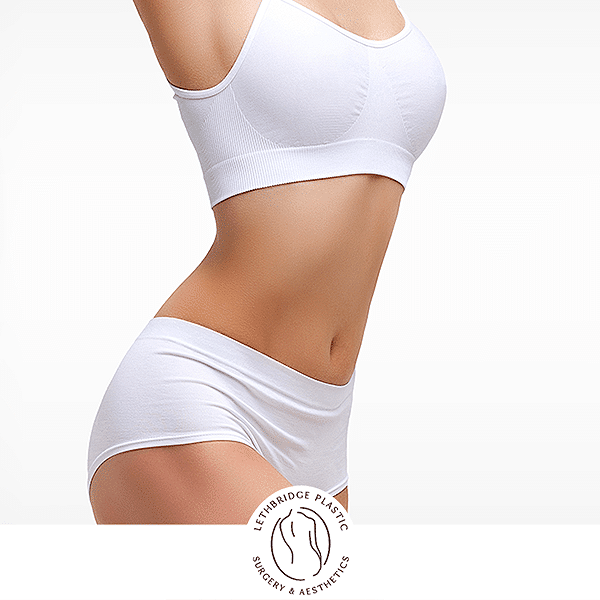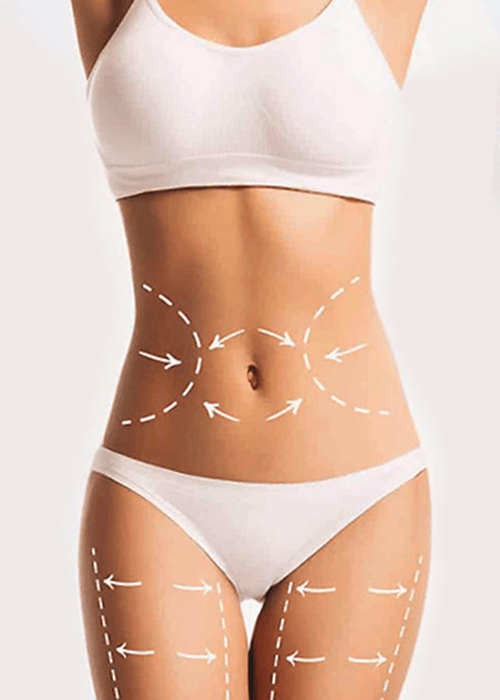Abdominoplasty in Lethbridge Alberta



Tummy Tuck in Lethbridge
Abdominoplasty is the surgical procedure in which excess skin and fat from the middle and lower abdomen are removed.
This procedure also involves bringing together the muscles of the abdomen in case they are separated. Dr. Secretan is highly skilled in this surgery and it is among the most frequently requested procedures in our practice.
It is important to note that abdominoplasty differs from liposuction, although liposuction may be combined with the surgery.
This surgery is appropriate for both men and women who are in good health. Women who have had multiple pregnancies may benefit from a tummy tuck, as it can tighten the abdominal muscles and reduce excess skin.
Types of Tummy Tucks
MINI TUMMY TUCK
MINI TUMMY TUCK
FULL TUMMY TUCK
FULL TUMMY TUCK
FLEUR DE LIS
FLEUR DE LIS
Is a Tummy Tuck Right For You?
Deciding whether or not to go forward with abdominoplasty is a very personal decision.
Those who have experienced extreme weight loss or have had dramatic changes to their bodies as a result of pregnancies are often left with excess fat, weakened muscles and excess skin which cannot be helped by diet and exercise alone.
This can be unsightly and shake a person’s confidence. In some cases, it can even contribute to medical issues such as back pain and hernias.
Those with only minor sagging around the abdomen may decide that it is not worth undergoing major surgery to correct – however this procedure is suitable for patients with any amount of sagging should they choose it.

Benefits of an Abdominoplasty?
Abdominoplasty or tummy tuck surgery can provide patients with physical and emotional benefits.
These benefits may include:
*a flatter stomach
*improved abdominal tone *enhanced muscle definition in the midsection
*a smaller waist
*heightened self-esteem *elevated confidence in regular clothing, swimwear, workout gear, and other apparel
Our talented plastic surgeons will assess your suitability for abdominoplasty during your consultation, as well as any supplementary procedures that can help you achieve optimal results.
For instance, the combination of liposuction and abdominoplasty can effectively reduce fat around the entire midsection and enhance the contour of the stomach, flanks, and back.
If your problem areas are limited to the lower abdomen (below the belly button), you might be a candidate for a mini tummy tuck instead.

Abdominoplasty in Southern Alberta:
If you are interested in an Abdominoplasty, the first step is a consultation with Dr. Secretan, our plastic surgeon. During your consultation Dr. Secretan will discuss your goals and treatment options.
LPSA is a full-service plastic surgery and medical aesthetics office located in southern Alberta. Our patients travel from all over Alberta, Saskatchewan and British Columbia to receive care from us, and we pride ourselves in offering the most effective and proven techniques available.
For a full list of our non-surgical interventions, please view our aesthetic services.
FAQ: About Your Surgery
FAQ: About Your Surgery
Your consultation, which typically lasts 45 minutes, will be your time to spend with Dr. Secretan, as well as the staff. We will discuss your goals and expectations and review with you the various options that exist in performing the procedure. Ample opportunity will be provided to ensure your personal comfort level with both the procedure and with us. Once you have decided to proceed with abdominoplasty, we will do our best to schedule your surgery as conveniently for you as possible.
Tummy tuck risks include:
- Anesthesia risks
- Bleeding
- Infection
- Fluid accumulation (seroma)
- Poor wound healing
- Skin loss
- Numbness or other changes in skin sensation
- Skin discoloration and/or prolonged swelling
- Unfavorable scarring
- Recurrent looseness of skin
- Fatty tissue found deep in the skin might die (fat necrosis)
- Deep vein thrombosis, cardiac and pulmonary complications
- Asymmetry
- Suboptimal aesthetic result
- Possibility of revisional surgery
- Persistent pain
These risks and others will be fully discussed prior to your consent.
There is a wide range in the cost of an abdominoplasty and there are a number of factors that determine the cost of this procedure from surgeon to surgeon. Some of these factors include: the experience of the surgeon, the amount of tissue that has to be removed and scope of the procedure.
A highly qualified surgeon who is in high demand will usually charge more than a less experienced doctor. Also, patients who have a lot of tissue that needs to be removed can expect to pay more than those with only minor sagging. If you are considering having multiple cosmetic procedures done, speak with Dr. Secretan about the possibility of having them all done at once.
For patients whose insurance will not cover cosmetic procedures, there are financing options available. Often patients will use a credit card or a personal line of credit, however our clinic offers financing through companies like Medicard that specialize in financing for cosmetic procedures.
Anesthesia Fees
These fees cover the cost of the anesthetist, whose presence is required during and immediately after your surgery, and the anesthesia administered.
Hosptial/Private Surgical Suite Fees
These fees cover the cost of where your surgery is scheduled to take place.
The Surgeon’s Fees
In addition to your actual surgery, these fees also cover all pre-operative and post-operative follow-up appointments with your surgeon. Miscellaneous costs include the compression garment and any supplies you’ll need while you recover (such as sterile bandages).
To determine the exact cost of your personal surgery, book a consultation with Dr. Secretan.
Most plastic surgery procedures are performed as an outpatient procedure, although overnight facilities are available for patients undergoing larger procedures or for those that are form out of town or come from a distance.
Before Surgery
Do not eat after midnight the night prior to surgery. You may drink clear fluids only, up to 6 hours prior to your scheduled surgery time. We will see you at the clinic before your surgery. We will usually do a few measurements and make several standardized markings before going into the operating room. Surgery is usually carried out under general anesthesia, but for some patients, and depending upon the procedure, local anesthesia with intravenous sedation is used. Our highly skilled anesthesia and nursing staff are there with you at all times to provide you with a safe experience in as caring and compassionate manner as possible.
Your Surgery
The length of surgery depends upon the procedure that you are undergoing. At the conclusion of the surgery, a very light bandage will be applied over the incision site. The anesthetist will have given you pain medication prior to the end of the surgery to minimize postoperative discomfort. From the operating room, you will be taken to our recovery area where you will stay until you are ready to go home. A recovery room nurse will be attending to you at all times to monitor your recovery and to ensure that you are comfortable.
After Surgery
Once you are ready to be discharged home, we will see you to review your postoperative instructions. You will be given a number to contact us or one of our staff 24 hours a day should you need any advice after leaving the clinic. Because you will have been under an anesthetic, your judgment and coordination may be affected for up to 24 hours. It is important to have a responsible adult pick you up from the clinic and stay with you the first night following surgery.
Following your surgery, there are several things that you should be aware of. Most important, if there is anything at all that you are uncertain about, please make sure to contact our office.
Recovery
After surgery some discomfort should be expected, however this can be controlled with prescribed medication. It is important to slowly walk around within the first two to three days, slightly bent forward to prevent any tension on the incision. You’ll be required to wear a compression garment for 4-6 weeks after the surgery. This controls swelling and helps the skin in the area conform to its new sleeker contour. It also helps with proper healing of tummy tuck scars. The return to work after your initial mini tummy tuck recovery can be as early as two weeks and 4 weeks for a full tummy tuck, depending on your comfort level.
The mini tummy tuck may not be as strenuous a procedure as the full tuck, and the resulting scar is less visible, however the focus on rest and recovery should be the same to promote successful healing. It can take 6-12 months to see the final result of body contouring surgery.
Immediately After Your Tummy Tuck Procedure
When you awake from your surgery you will be in the recovery room. Your incision will be well hidden in the low bikini line and groin. You will have your support garment on, and you will most likely not have any drains. If drains are present, there will be one or two soft drains exiting from the pubic area. You may feel some incisional pain and discomfort, but this is generally well controlled by pain medications. If you are not staying overnight, you will be able to go home when you have fully recovered from the sedation.
Activity During Your Recovery
Immediately after surgery, the skin will feel tight. For the first 2-3 days, you are encouraged to walk slightly bent forward to avoid pulling on the incision line, and to put pillows under your knees and your head when you’re reclining so you’re bent at the waist. You can also sleep on your side in a slight ‘fetal’ position (i.e. bent at the waist). You may find it difficult to rise from a lying position and it will be easier to turn on your side, allow your legs to hang over the side and slowly use your arms to raise yourself to a sitting position before rising. Avoid sitting up in a chair for the first week. You should plan to be off work for 2-3 weeks. During that time, you should take it easy – a little stroll is okay but not much more. We encourage you not to spend all your time in bed. This will minimize the risk of deep clots in your leg veins. Avoid straining, lifting, and bending completely over. You may be able to begin cardio type physical activity at 3-4 weeks. Strenuous physical activity (like lifting weights, abdominal crunches) is not permitted until 6 weeks after surgery.
Washing to Promote Healing of Your Incision
On the first day after your surgery, you can take a shower. Do not sit in a bath. When taking a shower, remove the support garment and underlying dressing. The small white tapes (called steri-strips) over your incision should be left on. You will need to hold the drains in your hand while you shower. You can wet and soap the tapes and your incision. Use mild soap such as Dove or Ivory. Pat yourself dry using a towel (do not rub) and put the dressing pad and support garment back on. This daily routine will help keep the incision and drain sites clean and will promote wound healing. Taking a bath will only be possible once the drains are out, the sutures around your bellybutton are out and the incisions are well on their way to being healed (approximately 2-3 weeks). Avoid swimming pools or whirlpools for at least 1 month.
Support Garment Worn During Recovery
The garment is necessary to support the tightening of your abdominal muscles. It will help to decrease swelling, prevent the accumulation of fluid under the skin, and to conform the skin to its new position, maximizing the cosmetic outcome. Failure to comply with garment instructions will increase the risk of seroma formation and suboptimal results. The garment should be worn day and night for 6 weeks, removing it only to shower or wash the garment. The support garment should cover the incision – if you notice it has slid upwards, you can slide it back down by pulling down at the sides.
Care of Your Incision
- Most of the stitching is dissolvable and woven under the skin to prevent stitch marks.
- Once a steri-strip (the little white tapes over your tummy tuck incision) starts to curl up at it’s edge, you can remove it the rest of the way and throw it out. After the steri-strips are removed, no dressing will be required over the incision.
- Avoid direct sunlight to the incision line as this may result in pigmentation changes. This is particularly true during the first year after the surgery. Never expose the incision to sunlight without sunblock – use SPF 30 or greater.
- Scars will initially be red and a little raised, but over 3-6 months they usually get lighter in colour and flatten out.
- The quality of your tummy tuck results may be compromised if you fail to return for any scheduled post-op visits, or follow the pre and post-operative instructions.
